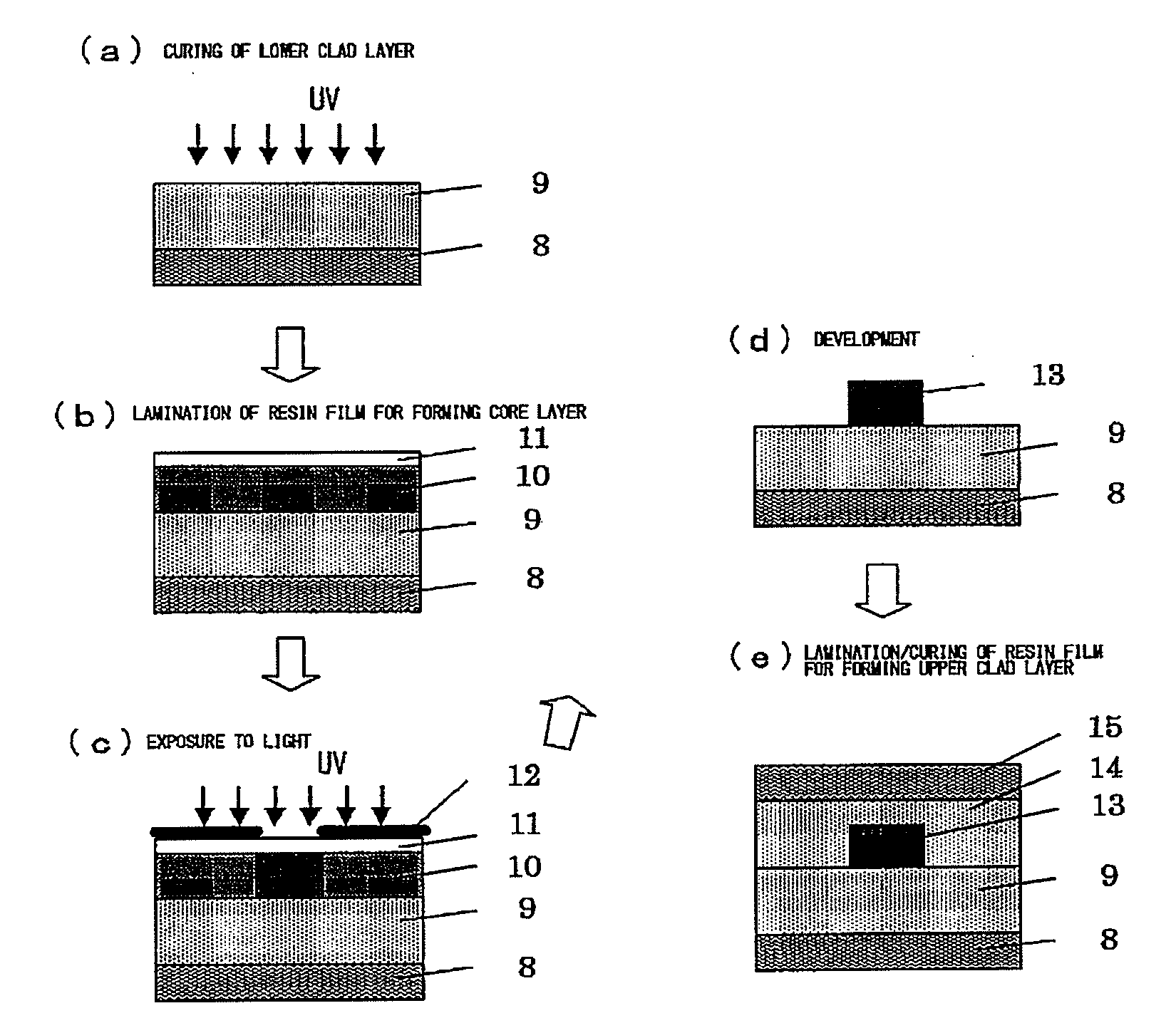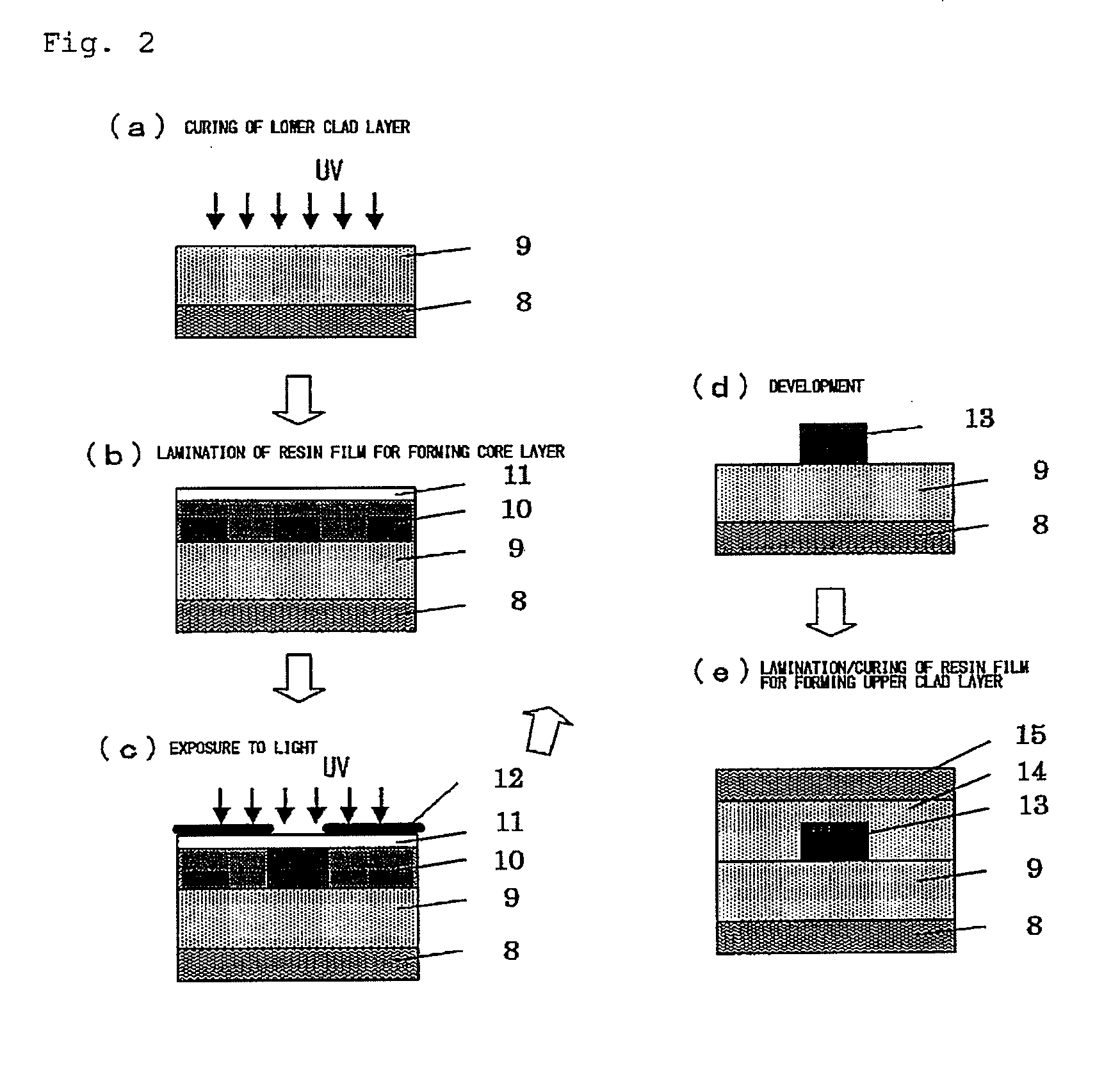Resin Composition for Optical Material, Resin Film for Optical Material and Optical Waveguide Using Same
a technology of optical material and resin film, which is applied in the direction of optical elements, photomechanical devices, instruments, etc., can solve the problems of difficult to realize a thickness of about 50 m, poor film thickness precision, and difficult to perform film formation on electric printed wiring boards. , to achieve the effect of high transparency, high heat resistance and high transparency
- Summary
- Abstract
- Description
- Claims
- Application Information
AI Technical Summary
Benefits of technology
Problems solved by technology
Method used
Image
Examples
example 1
[0173]Epoxyacrylate oligomer (trade name “HITALLOID”, manufactured by Hitachi Chemical Co., Ltd.) and phenoxy resin (trade name “YP-50”, manufactured by Tohto Kasei Co., Ltd.) were blended in equivalent mass ratio (using 50 mass parts per 100 mass parts of total resin of methyl ethyl ketone as a solvent). To this was added a three-component optical radical generator consisting of an optical initiator (2,2-bis(2-chlorophenyl)-4,4′,5,5′-tetraphenyl 1,2′-biimidazole manufactured by Tokyo Chemical Industry Co., Ltd.; 4,4′-bis(diethylamino) benzophenone manufactured by Tokyo Chemical Industry Co., Ltd., and 2-mercaptobenzimidazole manufactured by Tokyo Chemical Industry Co., Ltd.) in an amount of 2 mass parts based on 98 mass parts of total resin to provide a resin composition for forming an optical waveguide. This was applied on a PET film (“A4100”, manufactured by Toyobo Co., Ltd.) using an applicator (“YBA-4”, manufactured by Yoshimitsu Seiki Co., Ltd.) and dried under conditions of 8...
example 2
[0177]A resin film for forming optical waveguides was obtained in the same manner as that in Example 1 except that solid epoxy resin (trade name “Epototo YD-7020”, manufactured by Tohto Kasei Co., Ltd.) was used in place of the phenoxy resin. The thickness of the film was 12 μm.
[0178]The resin film for forming optical waveguides was treated in the same manner as in Example 1 to obtain a slab optical waveguide (core thickness 12 μm). The refractive index of the slab optical waveguide (core) was measured in the same manner as in Example 1. As a result, the refractive index was 1.565 for both TE polarized light and TM polarized light. This was passed through a solder reflow oven (“Salamander”, manufactured by Furukawa Electric Co., Ltd.) three times under conditions of a maximum temperature of 265° C. (retention time of 15 to 20 seconds at 260° C. or more) and nitrogen atmosphere.
[0179]Transmission losses before and after reflow were measured using a prism coupler optical characteristi...
example 3
[0181]A resin film for forming optical waveguides was obtained in the same manner as that in Example 1 except that acryl acrylate oligomer (trade name “HITALLOID 7975”, manufactured by Hitachi Chemical Co., Ltd.) was used in place of epoxyacrylate oligomer, and acrylic resin (trade name “HTR-860P-3DR”, manufactured by Teikoku Chemical Industries Co., Ltd.) was used in place of phenoxy resin. The thickness of the film was 12 μm.
[0182]The resin film for forming optical waveguides was treated in the same manner as in Example 1 to obtain a slab optical waveguide (core thickness 12 μm). The refractive index of the slab optical waveguide (core) was measured in the same manner as in Example 1. As a result, the refractive index was 1.505 for both TE polarized light and TM polarized light. This was passed through a solder reflow oven (“Salamander”, manufactured by Furukawa Electric Co., Ltd.) three times under conditions of a maximum temperature of 265° C. (retention time of 15 to 20 seconds...
PUM
| Property | Measurement | Unit |
|---|---|---|
| Percent by mass | aaaaa | aaaaa |
| Percent by mass | aaaaa | aaaaa |
| Percent by mass | aaaaa | aaaaa |
Abstract
Description
Claims
Application Information
 Login to view more
Login to view more - R&D Engineer
- R&D Manager
- IP Professional
- Industry Leading Data Capabilities
- Powerful AI technology
- Patent DNA Extraction
Browse by: Latest US Patents, China's latest patents, Technical Efficacy Thesaurus, Application Domain, Technology Topic.
© 2024 PatSnap. All rights reserved.Legal|Privacy policy|Modern Slavery Act Transparency Statement|Sitemap



